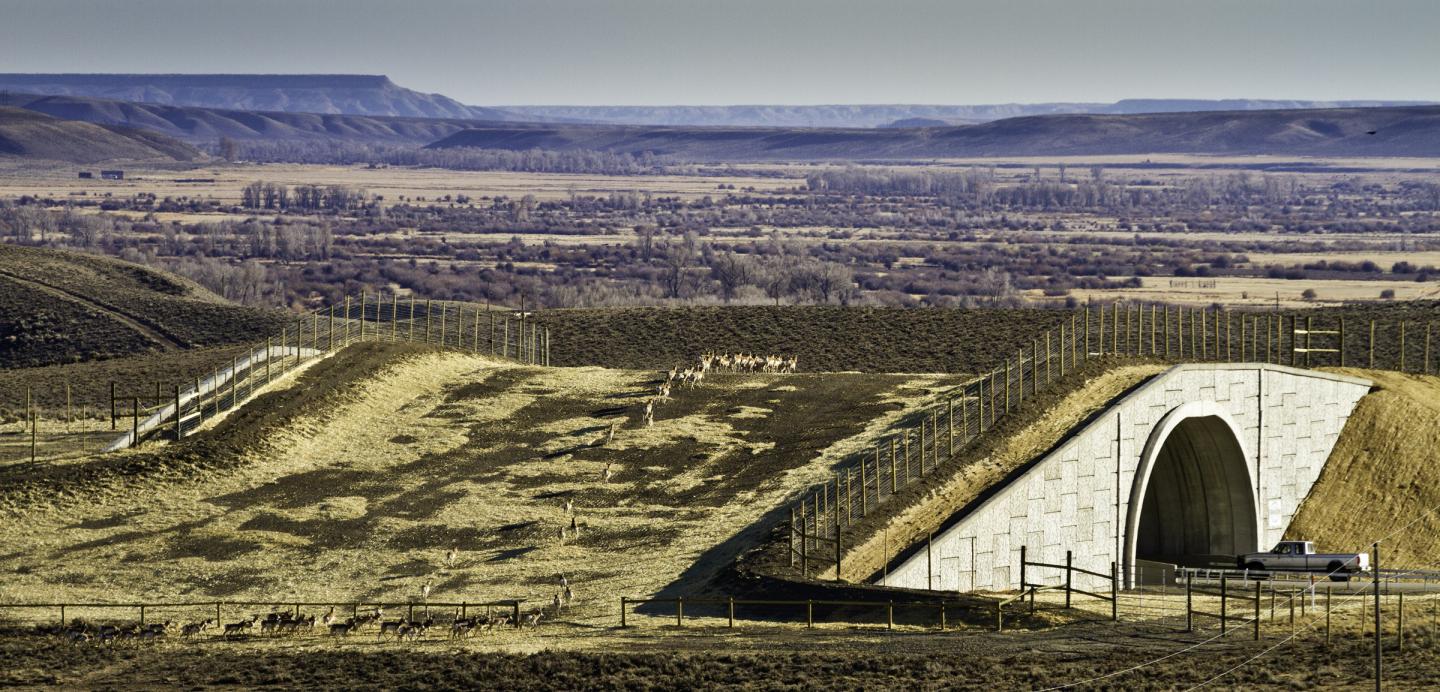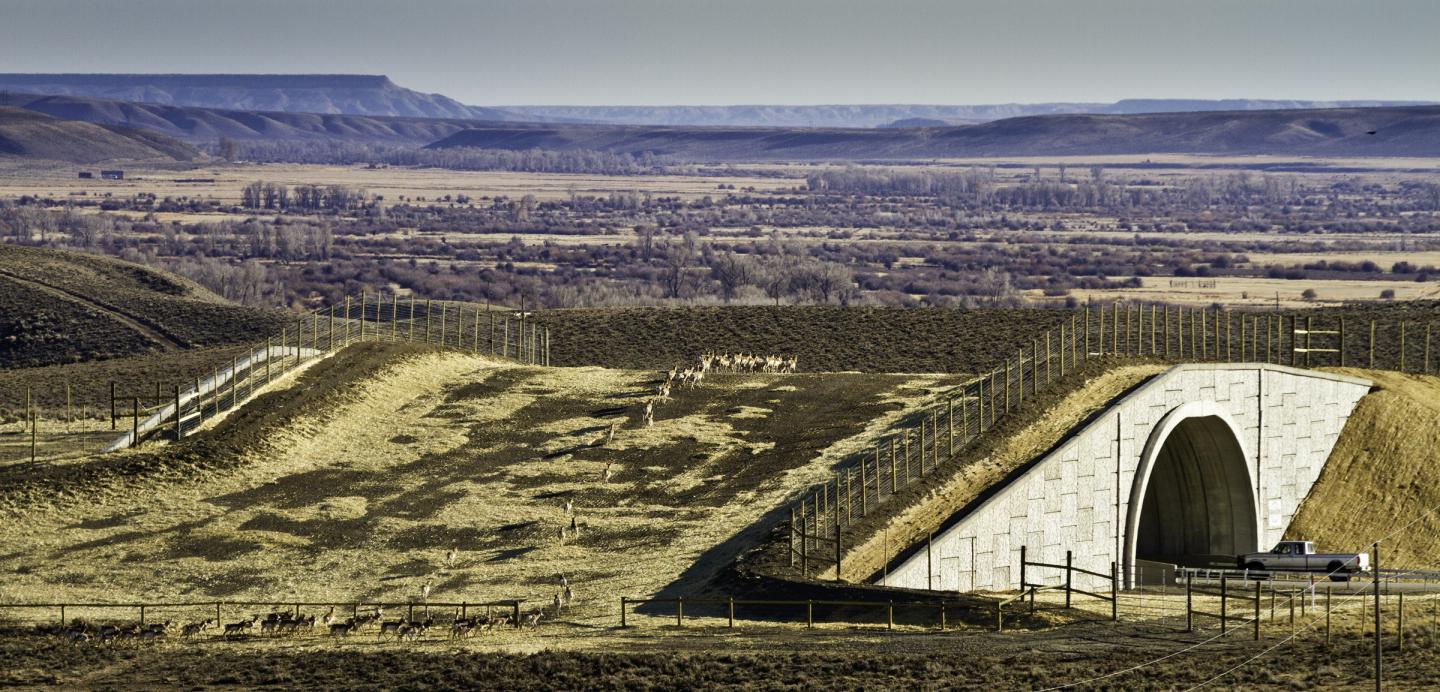
Credit: Jeff Burrell
A recently published study by scientists from the Wildlife Conservation Society (WCS) and Oregon State University has confirmed that efforts to protect migrating pronghorn by installing wildlife crossing structures over highways have succeeded, in terms of the increased success rate of pronghorn crossings over time.
This work, in combination with data from the Wyoming Department of Transportation that show a 70 percent reduction in wildlife-vehicle collisions after installation of crossing structures and fences, provides evidence that wildlife can adapt to using crossing structures meant to keep animals and drivers safe while allowing for continued wildlife migration.
In order to gauge a potential stress reaction by pronghorn to construction and crossing structures, the researchers designed their study to collect behavioral data when the animals approached the road. Past studies have shown that pronghorn react to vehicles similarly as they do to predators. If they react to crossing structures this same way, the crossing structures could actually negatively impact population dynamics by creating unnecessary stress.
The study titled "Highways, crossing structures and risk: Behaviors of Greater Yellowstone pronghorn elucidate efficacy of road mitigation" appears in the most recent edition of the journal Global Ecology and Conservation. The authors are: Renee G. Seidler, formerly with WCS, now the state Transportation Specialist for the Idaho Department of Fish and Game; Jon P. Beckmann of WCS; and David S. Green of Oregon State University.
The research is the latest effort in an ongoing project to monitor and protect the last known migration of pronghorn between Grand Teton National Park and the upper Green River Basin in western Wyoming. This wildlife spectacle, known as Path of the Pronghorn, stretches more than 170 miles annually and is one of the longest large mammal migration corridors remaining in North America. WCS researchers have conducted a range of studies to determine how human activities and development pose threats to pronghorn and their movements.
"The take-home message of this latest study is that, while pronghorn became more attentive at the new infrastructure 2-years post construction, they also more readily used the crossing structures over time," said Renee Seidler, lead author on the study and a Conservation Scientist with WCS at the time of the study. "The fact that pronghorn acclimated to these new structures increases the likelihood that a 6,000-year-old migration will continue, and that the $9.7 million invested in this project was a successful investment to help preserve this unique migration and increase the safety of the traveling public."
Conducted between 2011 and 2014, the study was designed to determine how the migrating pronghorn were behaving in response to the new construction and to assess the time it took for the animals to adapt to the novel structures on their migratory route. The study also compared pronghorn preferences for underpasses or overpasses. While wildlife crossing structures have been used in other areas to prevent wildlife-vehicle collisions, few studies have focused on potential elevated stress reactions to these projects over time.
After examining data about how pronghorn move through Trapper's Point Historical Monument–a pinch point in the "Path of the Pronghorn" (the first and only federally designated wildlife migration corridor)–the Wyoming Department of Transportation designed and built eight crossing structures across the road on a 20-kilometer stretch, including two structures at the Monument. Eight-foot-high fences were also installed along the highway to stop pronghorn from crossing on the road.
The data collected by the study authors during the construction phase revealed that pronghorn were wary when encountering the new structures, and preferred crossing the highway without using the structure, in spite of the risk of being hit by vehicles. By the end of the four-year study, all animals used the crossing structures to travel across US Highway 191. Given the choice of an overpass and an underpass, the pronghorn exhibited a clear preference for the overpass. The scientists also noted that, while vigilance behaviours increased over time, higher-level stress behaviors were low and did not increase over time.
Concurrently, pronghorn crossing success rates (a measure of how many times an animal attempted to cross the highway or a structure before they successfully crossed) increased over time, suggesting the animals became more acclimated to the structures within the four-year study.
"This study is helpful for wildlife managers on a number of levels, one of which is to provide a baseline of understanding on how migratory wildlife may respond to modifications of important migratory pathways over time," added Jon Beckmann, an author on the study and Director of Science for the WCS Rocky Mountain West Program. "The research also can help inform mitigation considerations for migratory land species in other regions across the globe."
The authors of the study make further recommendations that similar projects should be implemented in phases that minimize impacts to wildlife during construction.
###
The study was made possible with funding from National Fish and Wildlife Foundation and the U.S. Bureau of Land Management.
WCS (Wildlife Conservation Society)
MISSION: WCS saves wildlife and wild places worldwide through science, conservation action, education, and inspiring people to value nature. To achieve our mission, WCS, based at the Bronx Zoo, harnesses the power of its Global Conservation Program in nearly 60 nations and in all the world's oceans and its five wildlife parks in New York City, visited by 4 million people annually. WCS combines its expertise in the field, zoos, and aquarium to achieve its conservation mission. Visit: newsroom.wcs.org Follow: @WCSNewsroom. For more information: 347-840-1242.
Media Contact
John Delaney
[email protected]
718-220-3275
@TheWCS
http://www.wcs.org
Related Journal Article
http://dx.doi.org/10.1016/j.gecco.2018.e00416






